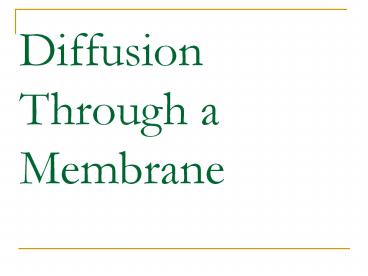Living Environment PowerPoint PPT Presentation
1 / 34
Title: Living Environment
1
Diffusion Through a Membrane
2
Diffusion Through A Membrane
indicator chemically indicates if a substance
is present by changing color
Iodine starch indicator solution Benedicts
solution glucose indicator solution must be
heated
3
Diffusion Through A Membrane
Diffusion movement of molecules from an area of
high concentration to a region of low
concentration no energy needed (this is called
passive transport)
4
Diffusion Through A Membrane
- we will use dialysis tubing to make a model of a
cell. - the tubing represents a semi-permeable cell
membrane - the dialysis tube is filled with a glucose
solution and a starch solution, sealed and rinsed
with water - it will be placed in a beaker with water and
iodine (an indicator) and allowed to sit
5
Diffusion Through A Membrane
The initial
set up
The Cell filled with glucose and starch
solutions
Water Iodine in the beaker cover the cell
6
Diffusion Through A Membrane Pg 2
- Question 9 Predict what you think will
diffuse. - Remember Theres starch and glucose inside the
cell and iodine outside the cell. - Write which way you think the substances will
move (into or out of the cell). - NO WORRIES! You will not be marked wrong if
your prediction (hypothesis) is incorrect!!! (So
write what you think!) - Make sure you list ALL three substances
- STARCH, GLUCOSE and IODINE
7
Diffusion Through A Membrane Pg 3
- Chemical Test Results Amber-Colored Starch
Indicator Solution - (Iodine)
If it changes from amber to dark purple/black,
starch is present (the result is positive for
glucose).
8
Diffusion Through A Membrane Pg 3
Remember that you must HEAT the test tubes
with the Benedicts Solution for this INDICATOR
to change color! If it changes to
orange/red when heated, glucose is present (the
result is positive for glucose).
- Blue-colored Glucose Indicator Solution
(Benedict's Solution)
9
Diffusion Through A Membrane Pg 3Table Two
Chemical Test Results
Indicator Solution Used Distilled Water Starch Glucose
Blue Colored BENEDICTS HEATED!
Amber Colored IODINE
10
Diffusion Through A Membrane pg 4
- Record any color changes observed in the cell
and in the beaker
11
Diffusion Through A Membrane
Final State What Color is the Cell Now?
What does that mean?
12
Diffusion Through A Membrane pg 4
- Record any color changes observed in the cell
and in the beaker
13
Diffusion Through A Membrane pg 4
14
Diffusion Through a Membrane
15
Initial and Final State
I Iodine S Starch G Glucose
I
I
I
I
I
I
I
I
I
S
G
S
S
S
G
G
I
I
I
I
Use the letters I, S, and G to represent the
substances used.
16
Diffusion Through A Membrane
glucose molecule
part of a starch molecule
17
Diffusion Through a Membrane
- Red Onion Cells
- Normal/Healthy Environment
18
Diffusion Through a Membrane
cytoplasm
red onion cells in tap water
cell membrane
cell wall
Cell membrane is pressed against the inside of
the cell wall
19
(No Transcript)
20
(No Transcript)
21
(No Transcript)
22
Diffusion Through a Membrane
bathing the cells in 10 NaCl (salt water)
NaCl
23
Diffusion Through a Membrane
cytoplasm
red onion cells in salt water
cell membrane
cell wall
Cell membrane and cytoplasm have shrunk because
water diffused out
24
Diffusion Through A Membrane
Which is in distilled (pure) water and which is
in salt water?
25
Diffusion Through A Membrane
- Applications
- salt on roads to melt snow
- intravenous saline solutions
- salty foods make you thirsty
- salt on slugs to kill them
- salty foods do not spoil as easily
- gargling with salt water
26
(No Transcript)
27
(No Transcript)
28
(No Transcript)
29
Isotonic
- "ISO" means the same
- If the concentration of solute (salt) is equal on
both sides, the water will move back in forth but
it won't have any result on the overall amount of
water on either side.
30
When Placed in Hypertonic Solution
- Plant cells, the central vacuole loses water and
the cells shrink, causing wilting. - Animal cells, the cells also shrink, called
crenation. - In both cases, the cell may die.
31
Hypertonic
- The word "HYPER" means more
- In this case there are more solute (salt)
molecules outside the cell, which causes the
water to leave the cell - Moving from high water concentration inside the
cell to a lower concentration outside the cell - Solutes can be salt or sugar or nutrients.
32
When Placed in Hypertonic Solution
- Plant cells, the central vacuole loses water and
the cells shrink, causing wilting. - Animal cells, the cells also shrink, called
crenation. - In both cases, the cell may die.
33
Hypotonic
- "HYPO" means less
- There are less solute (salt) molecules outside
the cell, which causes the water to enter the
cell - Remember if there are less solute particles,
then there are more water molecules. - Water moves from high concentration outside the
cell to low concentration inside the cell
34
When Placed in a Hypotonic Solution
- In plant cells, the central vacuoles (large
storage areas) will fill and the plant becomes
stiff and rigid (called turgor), the cell wall
keeps the plant cell from bursting - Animal cells are in danger of bursting because
they dont have a rigid cell wall - When the cell bursts it is called hemolysis
- When it bursts, it dies

